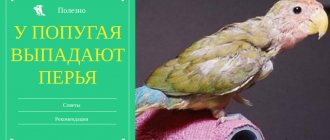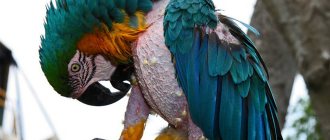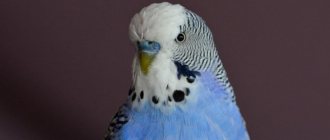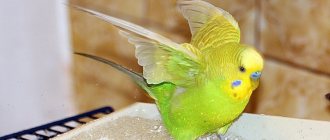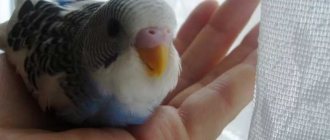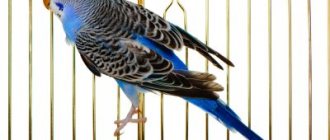Parrots are very cheerful and playful pets. They spend all their waking hours in motion. They chirp near the mirror, fly, and have fun with toys.
The activity and curiosity of the bird develops into affection for humans. In most cases, the person responds to the bird in kind, getting a lot of pleasure from spending time together. Beautiful cages, unusual toys, various islands of entertainment - all this makes it possible to observe her playful behavior.
But one day the owner notices a sharp drop in his pet’s playful mood. The bird loses its usual activity; it can sit for a long time on a perch or the bottom of the cage, ruffled. If we exclude diseases, then the state when the parrot is ruffled is a feature of its pastime.
During sleep, the parrot deliberately increases the volume of its plumage to better retain body heat. During the rest period, all physiological processes slow down, and the body loses precious heat. After awakening, the bird returns to active life again.
Diseases are the cause of the ruffled appearance
Unfortunately, very often the ruffled condition is accompanied by additional symptoms of the disease. At this moment, it becomes clear that changes are occurring in the pet’s body, the consequence of which is a decrease in body temperature. If the parrot is ruffled and sleeping, there is only one conclusion - the pet is sick.
Having discovered alarming signs, in order to avoid the neglect of the disease, you will need to identify the cause and begin treatment of the parrot. Studying symptoms and laboratory tests will provide a complete picture of the disease. If it is not possible to go to a specialized clinic, then treatment falls on the shoulders of the owner.
Possible diseases:
- Poisoning;
- Cold.
Are there preventive measures?
Despite the fact that parrots are quite unpretentious to their living conditions, they still need comfort and coziness. The homeland of these birds is in countries with hot climatic conditions, for this reason they need the same conditions in captivity. Hypothermia can be fatal for this species of bird; in particular, they can develop kidney disease, which is difficult to treat.
As a preventive measure against the occurrence of any disease, it is to avoid drafts and sudden temperature changes, since they are delicate and sensitive creatures and are so easily susceptible to colds.
They can easily catch an infectious disease from their owners, so if you are sick, do not go near them under any circumstances, most likely they will get infected from you, and it will not be so easy to cure them.
And most importantly, you should not take on the treatment of a parrot on your own, because you will still not be able to provide highly qualified assistance, and you will miss out on valuable time. Due to the fact that the metabolism of parrots is carried out at a high speed, all diseases in them develop extremely quickly. So, don’t be late and save your pet!
Poisoning
The causes of poisoning can be various factors:
- Poor quality food and water with possible bacterial and fungal infections;
- Foods prohibited for consumption by parrots;
- Accidental consumption of poisonous indoor plants by a bird;
- Chemical poisoning: aerosol substances used by humans in enclosed spaces;
- Intoxication resulting from direct contact with low-quality feeders, drinkers and toys made using toxic materials;
If the parrot gets ruffled and vomits, this is obvious poisoning.
Symptoms of poisoning include vomiting, seizures, and changes in the concentration and color of droppings. With severe intoxication, loss of coordination may occur. In some cases, trembling and paralysis. It is very important to notice this problem at an early stage and begin treatment immediately.
The parrot is cresting, but this is not caused by illness
When a budgie sits ruffled, this does not necessarily mean that it is sick. It is possible that this is due to stress. This is how a bird can react to an unusual environment or loud music. This shows that he is uncomfortable. If this is not accompanied by signs indicating the presence of a disease, then you can cope on your own.
It happens that a parrot gets cocky because there is not enough daylight in the winter. In this case, you need to use artificial lighting. For this, ultraviolet lamps are used, since there is not enough natural sunlight in the room. This can cause lethargy, stress, and metabolic disorders.
Treatment
At home, the first step is to ventilate the room. Provides fresh air, especially in cases of chemical poisoning. Liquid adsorbent preparations are used using a pipette or medical syringe. These include Enterosgel, Polyphepan or activated carbon.
Thick preparations, as well as activated carbon, are diluted with purified water to the state of liquid sour cream. Using a syringe, 2-3 drops are instilled into the corner of the beak. After each drop, make sure that the parrot swallows it.
Drugs that cause a laxative effect are used. You can use fresh flax decoction. The laxative may cause mild distress. To prevent dehydration, birds need clean water at all times. If she refuses to drink, then forcefully feed her 3–4 drops into her beak.
If he refuses food, then complementary feeding is done with baby milk-free porridge through an insulin syringe. The feeding procedure is performed every 2 to 3 hours. The amount of porridge depends on the type of parrot.
Dangerous manifestations and their consequences
To save the life of a feathered pet, it is important to understand what external signs indicate. For example, why does a parrot tremble or crawl? If you know what the reasons may be, the likelihood of a favorable outcome will increase.
When a parrot crows and closes its eyes, loses weight, coughs and yawns, the bird is probably sick with tuberculosis. The initial stage can be treated with tetracycline antibiotics according to the treatment regimen for psittacosis described above. In other cases, the pet faces death.
When getting a feathered pet, it is better to study the diseases of parrots yourself. This will help you understand what exactly threatens your friend and how to cope with illnesses without outside help. The following symptoms, inconspicuous at first glance, are dangerous:
- lethargy and inactivity,
- disheveledness,
- lack of voice
- the parrot shakes its head
- dulling of feathers.
What is important to know about parrot diseases is not how to cure the disease, but how to recognize the disease in time. Pay attention to even small deviations in behavior in order to provide timely help or consult a doctor.
Colds
The homeland of parrots, in most cases, is hot countries (Africa, Australia, South America). Any, even seemingly short-term, ventilation of the room can cause colds in birds. The temperature regime must always be observed, depending on the type of parrot.
Cold air, drafts, and swimming in cold water are the causes of the disease.
Symptoms:
- ruffled appearance;
- lethargy and apathy;
- lack of playful and active mood;
- the appearance of heavy breathing or shortness of breath;
- sneezing;
- mucous discharge from the nostrils;
- sagging of the bird's tail to an almost vertical position.
If the parrot is ruffled and trembling, this is a clear sign of a cold. In this case, the bird may refuse to eat food and water.
How can you help your parrot at home?
Often, trembling that is not accompanied by other dangerous symptoms can be easily eliminated. The pet needs to be warmed and calmed.
Stress management
Moving is a common cause of mental discomfort for a parrot. Changing his cage is no less stressful for him. At the same time, the pet will begin to get nervous, cackle, and tremble. The owner may not immediately determine the cause of this condition. To calm the bird, you need to talk to it quietly and affectionately. You can stroke and caress your pet if it is tame. The old drinking bowl, feeder, and perches are installed in the new cage. You need to move your favorite toy to a new place. This way, moving to a new house can be made less traumatic.
First aid for illnesses and hypothermia
In case of dislocations and fractures, the bird is immobilized. The bottom of the cage is covered with straw. The damaged limb is bandaged, and the pet is warmed with a lamp or blanket.
An open wound must be treated with a gentle antiseptic. Hydrogen peroxide is suitable for rinsing. The cage also needs to be wrapped. Warmth will help the bird get rid of chills.
For colds and hypothermia, the bird is warmed up and given a warm infusion of chamomile (1 tbsp per 1 cup of boiling water). A regular tabletop lighting device is installed next to the cage. The lamp for it is chosen with a power of 40–60 W, no more. The light should be directed at the cell at all times until the signs of hypothermia disappear. The lighting device cannot be placed at a distance of less than 20 cm from the cage. The air temperature in the bird house should warm up to + 30 C°. One half of the cage should be covered with a blanket to create shade. As soon as the bird becomes uncomfortable or hot, it can always hide in such a shelter. Warming is carried out while the feathered pet is awake. Do not leave the lighting fixture overnight. The lamp exposure time should not exceed 4 hours.
As soon as the parrot stops tucking and hiding its head, the lighting can be turned off. It is important to prevent heat stroke.
In winter, heaters are installed in the room. It is good to humidify the air periodically.
On a note! The temperature in the cage should be monitored when installing the lamp. A high, uncomfortable temperature is just as dangerous for a parrot as a low one. The optimal level is +25 Сᵒ.
What other symptoms should you be wary of?
In certain cases, contacting a specialist is simply vital. Delay threatens the parrot with death.
Let us highlight the following situations:
- fracture of limbs, tail or wing;
- the appearance of a bleeding wound on the body;
- signs of poisoning and digestive disorders;
- apathy, drowsiness;
- itching of the skin, excessive loss of feathers;
- partial or complete refusal to eat;
- convulsions;
- uncharacteristic cry, wheezing.
The sooner the diagnosis is made, the faster the bird’s condition will improve.
It will be useful for you to know what to do if your parrot constantly screams and creaks its beak.
Why do the budgerigar's wings tremble?
Let's look at the reasons that cause this non-standard behavior:
- Stress. Parrots, like all birds, are quite timid by nature. Therefore, any change, for example, a new cage, a change of environment, loneliness, causes severe panic in them. It is important to figure out what is bothering the bird and help him calm down faster. You need to constantly communicate with your pet.
- Hypothermia - drafts and cold air cause shivering. Parrots do not tolerate low temperatures well, as they are accustomed to a tropical hot climate. For heating, you can use a heater, a fluorescent lamp, after throwing the material over the cage.
- Diseases - to find out why the parrot’s wings are trembling, the veterinarian will prescribe tests, based on the results of which he will select the necessary therapy. The bird may have a cold, an upset digestive system, bruises, etc.
- Nutrition – lack of minerals and vitamins also contributes to tremors. In addition, low-quality food provokes poisoning. With a balanced diet, your pet will be cheerful, cheerful and active.
Thus, the causes of trembling are very diverse.
Desire to breed
Owners of ornamental birds sometimes observe strange behavior in their charges: the parrot sits for a long time on the floor of the cage in the corner, and then shakes itself off and flies up to its perch. You can't tell by his appearance that there is cause for concern. Such actions indicate that the parrot is preparing for childbirth.
Pregnant parrot
If a pair of mongrels live in a cage, it is quite possible that this is how the beginning of nesting manifests itself. It is recommended to support your pets' instincts by providing them with shelter. But if the only inhabitant of the home living space is a female parrot, it is necessary to suppress her desire for offspring. The mirror, twigs and paper should be removed from the cage. There should be no materials inside that could be used to build a nest. False incubations should be stopped, otherwise the parrot will lose its health in vain.
What does it mean if a parrot sits ruffled?
Parrots are very cheerful and playful pets. They spend all their waking hours in motion. They chirp near the mirror, fly, and have fun with toys.
The activity and curiosity of the bird develops into affection for humans. In most cases, the person responds to the bird in kind, getting a lot of pleasure from spending time together. Beautiful cages, unusual toys, various islands of entertainment - all this makes it possible to observe her playful behavior.
But one day the owner notices a sharp drop in his pet’s playful mood. The bird loses its usual activity; it can sit for a long time on a perch or the bottom of the cage, ruffled. If we exclude diseases, then the state when the parrot is ruffled is a feature of its pastime.
During sleep, the parrot deliberately increases the volume of its plumage to better retain body heat. During the rest period, all physiological processes slow down, and the body loses precious heat. After awakening, the bird returns to active life again.
Improper feeding
The Budgie is an active bird that is constantly on the move. A healthy parrot jumps from branch to branch, walks along the bottom and pecks grain, tears paper, but will not sit on the floor of the cage. Therefore, it is not entirely clear why the parrot suddenly began to spend a lot of time below. Perhaps his paws are tired of holding onto the perch, and he is more comfortable sitting on the tray. This condition is caused by poor diet: too much fatty food or lack of nutrients.
Obesity in parrots
You need to feed the animal not on demand, but on time, observing the portion size. If you don't follow a diet, your parrot will get used to overeating, which will result in excess weight. A heavy body puts stress on your legs and wings. An obese bird has difficulty moving and simply feels uncomfortable.
Monotonous eating
Warning! It should also be noted that hunger is one of the causes of weakness in birds. Perhaps the food is of poor quality and the parrot is not getting enough of it. In some cases, exhaustion may be caused by changing food to another that the bird does not like.
